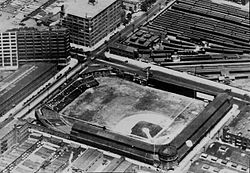 A 1928 aerial view of Baker Bowl with the soon-to-be-demolished Huntingdon Street station (at right) in Philadelphia | |
 | |
| Former names | Philadelphia Baseball Grounds (1887–1895) National League Park (1895–1913, officially thereafter) |
|---|---|
| Location | 2622 N. Broad St./2601 N. 15th Street, Philadelphia, Pennsylvania, U.S. |
| Coordinates | 39°59′35″N 75°9′21″W / 39.99306°N 75.15583°W |
| Public transit | Reading and Pennsylvania Railroad: Huntingdon Station (1891-1929), North Broad station (1929-1950) |
| Owner | Philadelphia Phillies |
| Operator | Philadelphia Phillies |
| Capacity | 12,500 (1887–94) 18,000 (1895–1928) 20,000 (1929) 18,800 (1930–38) |
| Field size | Left Field – 341 ft (104 m) Center Field – 408 ft (124 m) Right-Center – 300 ft (91 m) Right Field – 280 ft (85 m)  |
| Surface | Grass |
| Construction | |
| Opened | April 30, 1887 |
| Renovated | 1894-1895 |
| Closed | June 30, 1938 |
| Demolished | 1950 |
| Construction cost | US$80,000 ($2.71 million in 2023 dollars[1]) |
| Architect | John D. Allen |
| Tenants | |
| Philadelphia Phillies (NL) (1887–1938) Philadelphia Athletics (EL) (1892) Philadelphia Phillies (ALPF) (1894) Philadelphia Athletics (AtL) (1896-1900) Philadelphia Phillies (NFL) (1902) Philadelphia Eagles (NFL) (1933–35) La Salle Explorers (NCAA) (1931–36) | |
| Designated | August 16, 2000[2] |
National League Park, commonly referred to as the Baker Bowl after 1923, was a baseball stadium and home to the Philadelphia Phillies from 1887 until 1938, and first home field of the Philadelphia Eagles from 1933 to 1935. It opened in 1887 with a capacity of 12,500, burned down in 1894, and was rebuilt in 1895 as the first ballpark constructed primarily of steel and brick, and first with a cantilevered upper deck.
The ballpark's first base line ran parallel to Huntingdon Street; right field to center field parallel to North Broad Street; center field to left field parallel to Lehigh Avenue; and the third base line parallel to 15th Street. The stadium was demolished in 1950.
- ^ 1634–1699: McCusker, J. J. (1997). How Much Is That in Real Money? A Historical Price Index for Use as a Deflator of Money Values in the Economy of the United States: Addenda et Corrigenda (PDF). American Antiquarian Society. 1700–1799: McCusker, J. J. (1992). How Much Is That in Real Money? A Historical Price Index for Use as a Deflator of Money Values in the Economy of the United States (PDF). American Antiquarian Society. 1800–present: Federal Reserve Bank of Minneapolis. "Consumer Price Index (estimate) 1800–". Retrieved February 29, 2024.
- ^ "PHMC Historical Markers Search". Pennsylvania Historical and Museum Commission. Commonwealth of Pennsylvania. Archived from the original (Searchable database) on 2013-11-13. Retrieved 2015-06-18.
